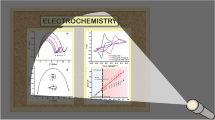Abstract
Spectroscopic behavior of poly-3-methylthiophene (P3MT) has been studied employing derivative cyclic volt-absorptometric (DCVA) techniques. In the DCVA technique, the derivative absorption signal (dA/dt) is recorded as a function of the applied potential. The dA/dt signals, the spectroscopic analog of electrochemical currents in cyclic voltammetry, are capable of monitoring the potential dependency for the absorption band effectively discriminating against nonfaradaic signals. The DCVA studies on the P3MT system show that the neutral form of P3MT, absorbing at 490 nm (at less than 0.3 V vs. Ag), changes to the radical cation form, which absorbs at 760 nm. Initially, the formation of the radical cation goes through an isosbestic point, indicating that the conversion of the neutral to radical (polaron) form is chemically reversible. However, upon increasing the electrode potential, the rate of the radical formation at 760 nm starts to decrease, with the formation of another band at about 1250 nm, attributable to a quinoid (bipolaron) form. This trend begins above about 0.6 V, shifting to a more positive voltage as the thickness of the film grows. This observation indicates that the electrochemical conversion of the neutral to radical form, followed by the quinoid form, is a slow process controlled by the diffusion of counter ions through the film. In-situ conductivity measurements as a function of applied potentials support the observed spectroscopic behavior.
Similar content being viewed by others
References
W.A. Little, Phys. Rev. 134A, 1416(1964); l(b). H. Shirakawa, E.J. Louis, A.G. MacDiarmid, C.K. Chiang, and A.J. Heeger, J. Chem, Soc., Chem. Commun. 1977, 578.
C.I. Simmionescu and V. Percec, Prog, Polum, Sci., 8, 133 (1982).
R.H. Baughman, J.L. Bredas, R.R. Elsenbaumer, and L.W. Shacklette, Chem, Rev, 82, 209 (1982).
A.O. Patil, A.J. Heeger, and F. Wudl, Chem. Rev., 88, 183 (1988).
R.B. Seymour, Editor, Conductive Polymer, Plenum Press, New York (1981).
J.C. W. Chien, Polyacetylene - Chemistry, Physics, and Material Science, Academic Press, New York (1984).
A.J. Epstein and E. M. Conwell, Editors, Proceedings International Conf, Low-Dim, Conductors, Mol, Cryst. Liq, Cryst., 83, 1033–1384 (1982).
M. Aldissi, Editor, Proceedings of the International Conference on Science and Technology of Synthetic Metals (ICSM '88), Elsevier Sequoia S.A. Lausanne (1989).
R.J. Waltman, J. Bargon, and A.F. Diaz, J. phys. Chem., 87, 1459 (1983).
S. Tanaka, M. Sato, and K. Kaeriyama, Makromol. Chem., 185, 1295 (1984); 10(b). Etemad, S; Heeger, A.J.; MacDiarmid A.G. Annu. Rev, Phys, Chem., 1982,33, 443.
K. Kaneto, S. Ura, K. Yoshino, and Y. Inuish, Jpn. J. Appl. Phys., 23, L189 (1984).
M. Sato, S. Tanaka, and K. Kaeriyama, J. Chem. Soc.. Chem, Commun., 1986, 873.
K.Y. Jen, G.G. Miller, and R.L. Elsenbaumer, J. chem, Soc.. Chem, Commun, 1986, 1346.
S. Hotta, S.D. Rughooputh, A.J. Heeger, and F. Wudl, Macromolecules, 20, 212 (1987).
S.N. Hoier, D.S. Ginley, and S.-M. Park, J. Electrochem. Soc., 135, 91 (1988); (b). Kaneto, K.; Kohno, Y; Yoshino, K. Mol, Cryst. Liq. Crys. 1985, 118, 217.
E.W. Paul, A.J. Ricco, and M. S. Wrighton, J. Phys. chem., 89, 1441. (1985).
C.-H. Pyun and S.-M. Park, Anal. Chem.,. 58, 251 (1986).
D.E. Stilwell and S.-M. Park, J. Electrochem. Soc, 136, 427 (1989).
C. Zhang and S.-M. Park, Anal. Chem, 60, 1639 (1988); (b) C. Zhang and S.-M. Park, Bull, Korean Chem, Soc, 10, 302(1989).
S.N. Hoier and S.-M. Park, 4thInt, SAMPE Electronics Conf., 4, 357. (1990).
Acknowledgement
We wish to thank M. B. Sinclair and M. A. Valdez, Sandia National Laboratories, for the fabrication of the electrode for the conductivity experiment. This work was supported by the United States Department of Energy under Contract DEAC04-76DP00789.
Author information
Authors and Affiliations
Rights and permissions
About this article
Cite this article
Hoier, S.N., Ginley, D.S. & Park, S. In-Situ Derivative Cyclic Voltabsorptometric Studies On Poly-3-Methylthiophene. MRS Online Proceedings Library 214, 169–175 (1990). https://doi.org/10.1557/PROC-214-169
Published:
Issue Date:
DOI: https://doi.org/10.1557/PROC-214-169




